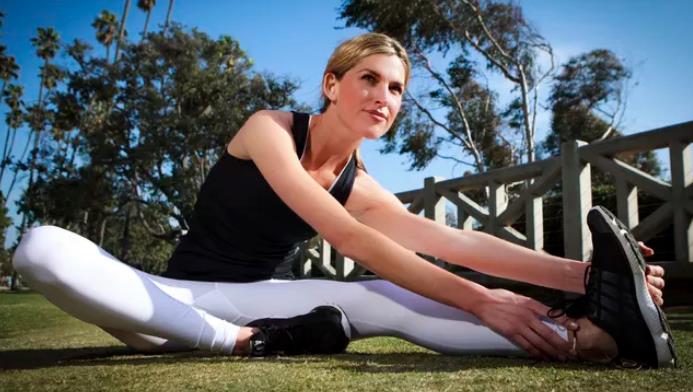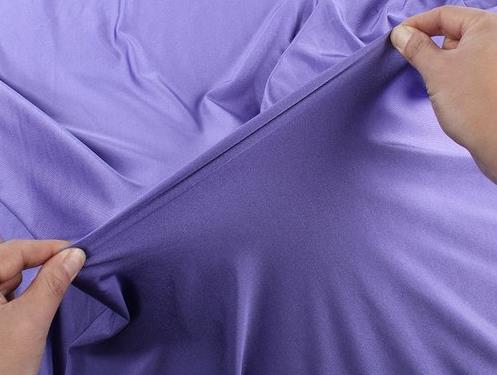Introduction
Lycra is a material that revolutionized the fashion industry when it was first introduced in the late 1950s.
But have you ever stopped to think about what is LYCRA fabric?
If you have, then read on until the end of this article, as we will tell you all about it.
What is lycra fabric?

Also commonly known as spandex and elastane, LYCRA is a registered brand for a specific style of stretchy synthetic fabric.
Originally developed by the DuPont Corporation in the late 1950s as a replacement for latex, the beauty of lycra is that it can expand to up to 8 times greater than its regular size.
For the fashion industry, this means they can make quality garments with LYCRA that are more comfortable, fit and shape better, give more fluidity of movement and have more robustness.
LYCRA is a polymer. It is made of long monomer ‘chains’ which link together via special forms of acid. Other polymers include nylon, polyester and epoxy.
One of the key points of difference that sets LYCRA apart from other types of synthetic materials is that they can resist well to heat.
Thus it is seen as an excellent material to add to fabrics like nylon and polyester to create better fitting clothes.
In practical terms this means that when you slip on a pair of leggings or skinny jeans, and you are able to stretch the garment to fit your specific body shape, you can best do so due to the elastic presence of LYCRA in the material.
How Is Lycra Fabric Made?
The process for making LYCRA is highly technical. But it can be categorized as follows:
- The substances of macro glycol and diisocyanate monomer combine to form the prepolymer – the baseline ingredient for LYCRA .
- This mix is subjected to increasing pressure and heat levels to ignite a chemical reaction that creates the prepolymer.
- It is then exposed to diamine acid, to produce a ‘chain extrusion reaction’ which forms a sludge like consistency.
- Solvent is added to thin out the substance.
- Once thinned its poured into a ‘fiber production cell’. The machine has a spinneret that forces the solution to go through it, and flood out the other side, in the form of fibers.
- These fibers are exposed to heated nitrogen, and a solvent gas solution, which transforms them from a liquid state, to a more solid one.
- Once solid, the fibers are extruded from the spinning cell mechanism, and formed into twisted strands by a compressed air device.
- These fibers are exposed to a finishing agent which forms it into a yarn – ready for weaving.
- Once completed, the LYCRA is transferred to a large spool, prior to being shipped to a textile manufacturing plant.
LYCRA Uses
LYCRA is widely used around the world, within the consumer textiles industry, for the manufacturing of clothing.
Typically they are a key component in form-fitted items like underwear, for both men and women, and casualwear like leggings and sweatpants. Where it is usually found in the waistband area.
It is also used in many types of sportswear items including swimming costumes, cycling shorts and hiking apparel, that require them to be snug fitting without being too uncomfortable to wear.
LYCRA is also found in most types of socks too, as this makes them much easier to stretch and fit around the shape of your feet.
What Different Types of LYCRA Fabric Are There?
Overall there are three types of LYCRA available.
Apart from the way they are made, there is no discernible difference between them.
However it is important to know the following:
LYCRA:
This type of fabric is a registered trademark of the DuPont corporation.
It is widely considered to be one of the best and most dependable types of elastane fabric on the market.
As a general rule it is more expensive than other types of spandex, but it is a quality product, nonetheless.
Elastane:
A term prevalent in Europe, it is, technically speaking, the correct term to represent these polyether-polyurea copolymer types of fabric.
Spandex:
Invented by a chemist called Joseph Shivers in the 1950s, this is the term used by DuPont during the development process of their polyurethane fabric, prior to LYCRA being officially trademarked.
An anagram of the word ‘expands’, it is the commonly used term in North America.
How can you tell if fabric is LYCRA?

As LYCRA is a registered brand of the DuPont Corporation all their products have a label on them that features the logo.
This takes the form of a (usually red) triangle, with a waved flourish on the bottom that features the word LYCRA in its center.
Sometime it is accompanied by a strapline that says, ‘only by Dupont’.
The Difference in LYCRA & Cotton
There are distinct differences between LYCRA and cotton.
For instance LYCRA is very stretchy, whilst cotton is not. So this allows it to retain its shape better.
It is also much more durable too, as well as wrinkle-free. Which is why more clothing companies manufacture with it.
In addition LYCRA tends to be quick drying. Thus making it the perfect fabric for swimwear, and clothing required for other sports.
Cotton also comes from a plant, whilst LYCRA is synthetic.
This makes it more expensive to produce as well, which is another reason why elastane products are an attractive proposition to clothing manufacturers.
What is the difference between Spandex and LYCRA?
Spandex and LYCRA are essentially the same thing – a synthetic fabric known for its elasticity.
In the same way as Levi’s is often used to describe a specific type of jeans, LYCRA is a brand name for a particular elastane product made by DuPont.
Spandex on the other hand is a commonly used name to describe all types of elastane products.
Thus it follows that many companies can advertise selling spandex clothing, but only DuPont can market the LYCRA brand.
There is no difference in the properties of these fabrics, though they can vary depending on what amount of elastane are used in the fiber.
For instance some clothing items might feature 90% cotton and 10% spandex fabric. While other may have a 95% to 5% ratio.
Perhaps the best way to distinguish between the two, is to remember that spandex is a generic fiber category and lycra is a specific spandex fiber thread.
What are the disadvantages of LYCRA?
Whilst LYCRA remains a very popular type of fabric in the clothing industry today it does have some disadvantages to it.
During periods of high humidity wearing garments made from this type of fabric can trigger skin allergies as it does not have the ability to absorb sweat from your skin that gets trapped underneath it.
Similarly LYCRA based underwear can cause yeast infections too.
These types of garments also tend to have a shorter shelf lives as they often lose their shape after a few washes. Also, as they can’t be washed in very hot water it is a more time consuming material to clean.
Is LYCRA fabric good for summer?
As previously alluded to, LYCRA is not great when it comes to breathability, as it does not have the capacity to absorb moisture secreted by your skin.
As a result wearing clothing made of this fabric during the height of the summer, could make you feel hot, constricted and uncomfortable.
Is LYCRA durable?
LYCRA is a fabric that is known for its quality and durability. Infact, it might surprise you to discover that it is actually stronger and more durable that rubber.
Clothing made of this material tends to last longer than those made without it. Which is just one of the many reason why buying clothing items made of this fabric can represent an astute purchase.
It is also heat resistant so won’t damage if regularly exposed to the sun. While if properly looked after, it tends to keep its shape for much longer too, than clothes made from other materials like cotton.
Is LYCRA safe to wear?
Whilst LYCRA is a synthetic fiber, it is not regarded as a toxic material to wear. Therefore it is safe, in the sense that it should not do any long term damage to your health.
That said, because of its lack of breathability, its clothing and underwear has been known to cause skin allergies and yeast infections.
How can I sew LYCRA fabric?
LYCRA is a fabric that can be sewn. But because of its stretchy nature this can make it difficult to do so.
However if you follow these tips, you should be able to use a regular sewing machine.
- Cut the pattern to ensure the greatest amount of stretch goes around your body.
- Pin the fabric inside the seam allowance before you start to stitch.
- Use a Jersey or stretch needle, as these types work best.
- Use woolly nylon thread as most cotton threads won’t stretch as much as they do.
- Keep the fabric a little bit stretched as you sew.
- Paper acts as a great stabilizer if you put them in between the fabric as you sew.
How can I maintain LYCRA?
To ensure your garments retain their overall quality and elasticity it is important to wash them properly.
Their care labels will give you exact instructions. But as a general rule always hand wash your LYCRA clothing to ensure it doesn’t overstretch.
Use lukewarm water and avoid washing detergents that have chlorine bleach or fabric conditioner in them as they could ruin the garment.
To remove odors add a small cup of bicarbonate of soda to the sink or bucket and allow to soak overnight.
Rinse well in repeated changes of lukewarm water. Once finished, do not wring out excess water. Instead you can remove it by rolling in a clean towel.
Never dry your LYCRA garments in a tumble dryer.
Conclusion
Whether or not the DuPont corporation had any idea of the incredible impact their invention would have when they first came up with it in the 1950s, we will never know.
But when you consider that billions of people around the world use, or wear, LYCRA products every single day it really is actually quite mind-blowing.
